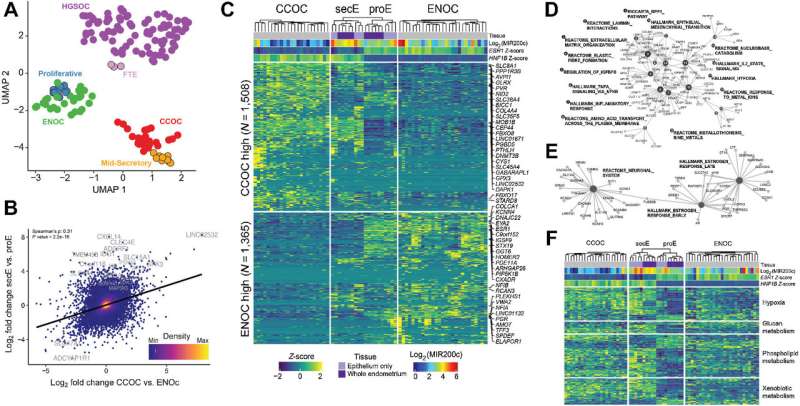This article has been reviewed according to Science X's editorial process and policies. Editors have highlighted the following attributes while ensuring the content's credibility:
fact-checked
peer-reviewed publication
trusted source
proofread
For some endometriosis-related ovarian cancers, timing is everything

Two types of endometriosis-related ovarian cancer arise from the same cells but likely at different stages of the menstrual cycle—a nuance that significantly influences treatment response, reports a recent study led by Van Andel Institute and University of British Columbia scientists.
The findings, published in the journal Cancer Research, have implications for better understanding and treating a pair of cancer subtypes that together account for up to nearly a quarter of ovarian cancer cases. Clear cell ovarian carcinoma comprises 5%–12% of ovarian cancer cases and is resistant to chemotherapy. Endometrioid ovarian carcinoma comprises 5%–10% of ovarian cancer cases and responds better to therapy.
"Clear cell ovarian cancer and endometrioid ovarian cancers arise from the same cells and have similar genetic mutations but they are vastly different in terms of disease progression and outcomes," said VAI Professor Hui Shen, Ph.D., the study's co-corresponding author. "Our study shows that important differences between the two types can be linked to the stage of the menstrual cycle during which the cancer begins. We hope our work will inform more precise treatment strategies and improve outcomes."
Historically, cancers have been categorized based on the specific organ or tissue in which they first appear. Thanks to advances in technology and large-scale cancer characterization projects such as The Cancer Genome Atlas, scientists now know that cancers widely vary at the molecular level, even those that originate in the same tissues or cells.
Unlike other ovarian cancers, clear cell ovarian carcinoma and endometrioid ovarian carcinoma are believed to begin in endometriosis-related cysts. Endometriosis is a painful disorder in which the uterine lining grows outside of the uterus, causing inflammation and scarring.
During the menstrual cycle, hormone levels and other cellular communication signals fluctuate, pushing cells to experience different states in response to their shifting environment. Shen and her colleagues found that cancer cells retain the characteristics of the cell state that was underway when they became malignant. It's likely that these phase-dependent cell states determine whether an ovarian cancer becomes clear cell ovarian cancer or endometrioid ovarian cancer. Shen and colleagues demonstrated that these cell state differences become locked in during cell replication via an epigenetic mechanism, which influences how genetic instructions are used without changing the DNA sequence itself.
In addition to pinpointing important epigenetic differences between subtypes, the study also provided support for further research into the role of iron in cancer cells. Based on their observations, Shen and colleagues suggest that clear cell ovarian carcinoma cells may hoard iron, potentially from the menstrual blood trapped in endometriosis-related cysts. Clear cell ovarian carcinoma cells also seem to rely on certain molecular alterations to counteract iron-induced cell death, a process called ferroptosis. There are few effective treatment options for people with late-stage clear cell ovarian carcinoma. The team's findings underscore the potential of targeting ferroptosis as a possible therapeutic approach and pave the way for additional research.
VAI's Ian Beddows, Ph.D., and Huihui Fan, Ph.D., are co-first authors of the study. Other authors include Benjamin K. Johnson, Ph.D., and Svetlana Djirackor of VAI; Karolin Heinze, Ph.D., Anna Leonova, Janine Senz, and David G. Huntsman, M.D., FRCPC, FCCMG, of University of British Columbia; and Kathleen R. Cho, M.D., and Celeste Leigh Pearce, Ph.D., MPH, of University of Michigan. Michael S. Anglesio, Ph.D., of University of British Columbia is the study's co-corresponding author.
More information: Ian Beddows et al, Cell State of Origin Impacts Development of Distinct Endometriosis-Related Ovarian Carcinoma Histotypes, Cancer Research (2023). DOI: 10.1158/0008-5472.CAN-23-1362





















